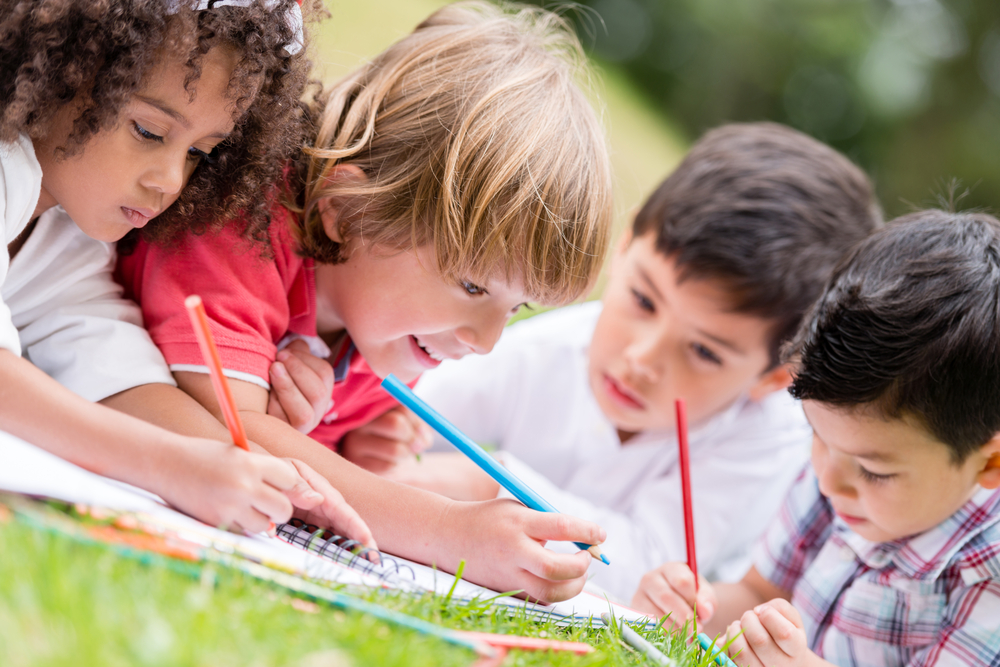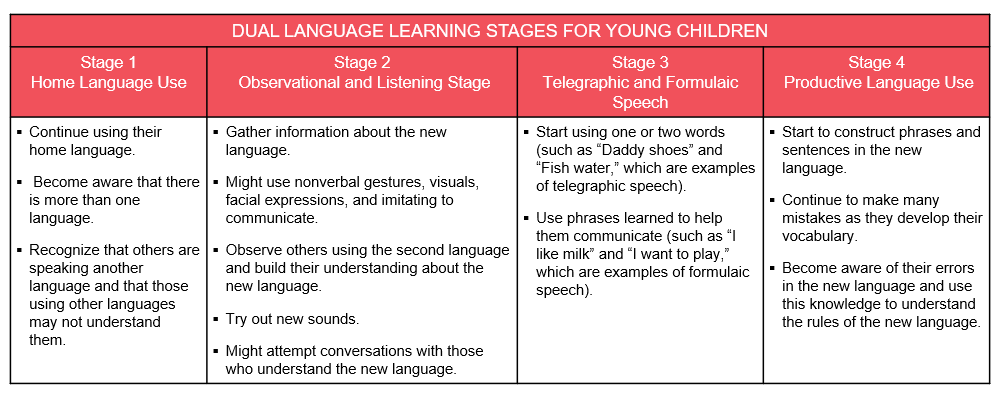
APPENDIX B:
Supporting Dual Language Learners (DLL)
Supporting Dual Language Learners (DLL)
The Dual Language Process
The process of learning a second language is complex, particularly when children are learning a second language at the same time, they are learning their home language. In fact, the process of learning a second language is similar to learning a first language as it happens over a period of years. Also, children go through similar stages, such as babbling nonsense sounds, saying their first words, putting words together into phrases, and eventually speaking in full sentences. However, there are some differences in the language learning process when children are learning two languages at the same time. For instance, they may use the language they know best (their home language) when they try to speak the second language. This is called “code switching.” A child might say, “Me gusta cookies,” mixing the Spanish words “Me gusta” (“I like”) with an English word (“cookies”). Examples such as this show that children are making progress in learning the second language, although it may seem like they are confusing their home language and the second language. This example also shows that learning language takes time. Although it might appear that children are quickly picking up learning the new language, it can take many years to become fluent and learn how to use it in different contexts.
Children's ability to learn a second language is influenced by many factors:
- Exposure to new language: children who interact more often with persons who speak the second language will generally learn the second language more quickly.
- Child's temperament: children who are shy or are in settings where their home language is used frequently may not learn the second language as quickly as children who are outgoing and/or children in settings where the second language is used more frequently. Research has shown that children learn English more effectively if they are in settings where both their home language and English are used. When children can hear their own language and English, they can pick up concepts more easily and begin to understand what the English words mean because they can use clues from their home language.
Dual Language Learners and the SD Early Learning Guidelines
While it may seem that learning two languages at a young age might interfere with a child’s learning and development in other areas, it turns out that being a dual language learner is beneficial for children. In fact, research shows that DLLs often experience improved cognitive and social development. They are better at critical thinking skills, are more creative, acquire some literacy skills more quickly, and have a greater sense of respect for differences among people.
Despite these potential advantages, there are several considerations adults who work with dual language learners need to keep in mind when supporting children’s progress in all the areas described in the guidelines.
First, it is important to remember that at the same time they are acquiring a second language, DLLs also need to learn the skills described in the SD Early Learning Guidelines, such as early mathematics skills, early literacy skills, science, and social studies. Therefore, when planning learning experiences in areas such as these, adults need to take steps to make the content more accessible or understandable to children who speak another language. Using props and visual pictures can be one strategy to help with teaching the concepts. Because DLLs may still be learning the vocabulary the adult is using, it’s important to check to make sure they really understand the concept rather than relying on a simple correct answer that they might offer to questions.
When working with any child, but particularly with DLLs, adults can get a better understanding of what the child is thinking by asking why they gave a particular answer or how they decided what to say or complete an action if they are demonstrating a skill. Adults can also check for understanding by asking the children to demonstrate concepts using manipulatives to indicate specific number, etc. Probes such as this will help adults get a better feel for whether the child really understands the concept they are trying to teach.
It is also important to think about how to integrate children’s social and cultural experiences at home into the curriculum. Building on what the children experience at home is more effective than introducing new skills and concepts in a way that is unfamiliar to DLLs. Young DLLs acquire knowledge of mathematics and science while they are engaged in daily routines and activities that are part of the cultural practices of their families and communities. Adults need to incorporate families’ daily routines that involve mathematical and science learning into their curriculum.
Finally, adults should help DLLs demonstrate what they know in different ways, beyond just answering questions verbally. Young DLLs might demonstrate what they know through gestures, their first language, using pictures, or using props such as blocks or other objects. A knowledgeable and observant adult can often determine children’s understanding of concepts even if they cannot express them verbally in academic English.
All children, including DLLs, should have experiences that help them make progress on the skills and knowledge described in the Early Learning Guidelines. Teachers and caregivers who provide support for the children to continue to use their home language, who are knowledgeable about and value the children’s home culture and family, and who intentionally seek to help children learn both English and concepts from the SD Early Learning Guidelines, will effectively support the learning and development of dual language learners.
Different terms have been used to describe children who speak a language other than English at home: English language learner, second language learner, limited English proficient, to name a few. This document uses the term Dual Language Learners (DLL). A dual language learner is a child who is learning a second language, in most cases English, at the same time he or she is learning their first or home language. The term dual language learner highlights the fact that the child is learning two languages, or becoming bilingual, which is an important consideration for adults. Adults should think about how the child is learning both the home language and English. In fact, children can become DLLs in many ways. Some are exposed to both languages from the time they were born, while others are exposed to one language first, and then begin to learn English later.


A growing number of South Dakota’s young children may speak a language at home that is not English. It is important for adults, who work with dual language learners, to understand how they develop in order to support their progress on the skills and knowledge described in the SD Early Learning Guidelines. While this brief section cannot provide all the information adults might need when working with children who are dual language learners, it provides a starting point. By describing Dual Language Learners (DLLs), providing information on how to work with children and families, and presenting ideas for how to use the guidelines, the hope is that a greater understanding will be appreciated.

Dual Language Learners are not just learning a second language. They also are growing up in a culture that is different from the culture of an English-speaking home. Therefore, in addition to considering their language development process, adults must also think about the culture that children experience in their families and communities. In fact, the culture children experience can impact how they use their language, their general approach to learning, and their motivation to learning the knowledge and skills described in guidelines. When thinking of how to best meet the needs of DLLs, adults need to consider variations in individual cultural practices as well as language differences among the children with whom they work. For instance, there may be cultural differences in the degree to which children are expected/taught to explore on their own or to express curiosity. Families may also differ in the extent to which they want their child to show independence and do things for themself. Adults must be sensitive to cultural differences in how and what children learn across all areas of their development.
Limited understanding of the education system and language barriers can get in the way of families’ participation. Also, because of cultural differences, family members may view adults as “the experts” and be uncomfortable voicing their own observations of the child and/or concerns. Adults should take steps to understand the challenges that families face and to provide information and resources that might help to overcome those obstacles.
It’s important to remember that both verbal and nonverbal messages can convey interest and empathy, which build trust. This is particularly true in cross-cultural and cross-language exchanges. Therefore, adults need to be aware of both what they say and how they say it and be careful to treat families with respect and openness.
It is, however, difficult for many early learning programs and schools to provide support for children to use their home language because the adults may not speak the children’s home language. However, providing no support in the child’s first language can have negative effects in many aspects of the child’s cognitive development.
Therefore, it is worth trying, in any way possible, to help the children use both their home language and English. Adults who speak only English might seek out parents and members of the community who speak the children’s language to volunteer in the program. Encourage family members to continue to speak to the child in their home language.
Remember, children may appear to have completely adjusted to the new language and be functioning appropriately in an early learning environment (using English and following classroom routines and rules), but their language learning process is far from over. It is important to continue to provide support and use strategies or adaptations that help make progress on their skills and knowledge.
Tips for educators when working with children and families who do not speak English
Supporting English Language Development When Children Have Little Experience With English
Language Modeling With Dual Language Learning Infants
While early educators commonly acknowledge that members of a child’s family are the first and most important teachers in a child’s life, this view is especially important for DLLs. Family members know their child best and can provide unique insights into the child’s development, particularly their language development. For example, families can inform adults about the child’s home language development, especially in those cases when the adults speak only English. The families, their culture, and their language are assets in educating their child, and they bring considerable resources to the program the child attends. Instead of thinking about what a family or a child does NOT know or understand, we should consider and honor what they DO contribute to the education of their own child and to the program. It is important to use a strengths-based approach to working with children who are dual language learners and their families.
When working with DLL families it is important to ensure that families have the support that they need, including translation of written documents and interpretation services for oral communication, to fully participate in their child’s education. Parents of DLLs may have limited literacy in their own language so materials should be available in a language that the parents can read, and in formats such as videos that can be understood by non-literate parents. Also, family members may experience difficulty participating in meetings (such as IEP meetings) to discuss their child’s needs or progress.
Another important aspect of working with DLL children’s families is the need to build mutual trust. Adults can foster either trust or distrust, depending on how they relate with family members. It’s important to remember that both verbal and nonverbal messages can convey interest and empathy, which build trust. Also keep in mind members of families that have experience in early learning environments or preschool program can be great allies in building trust. They can explain what to expect and introduce adults to new families, helping them get off to a smoother start in the program. Relying on experienced families to help build relationships with other families can be a good strategy.
